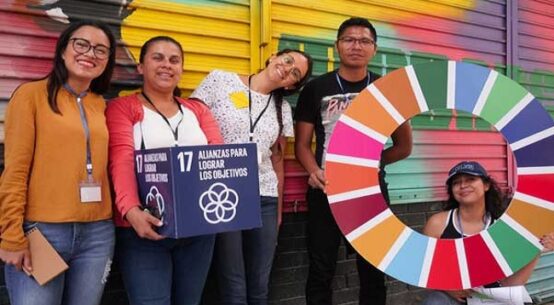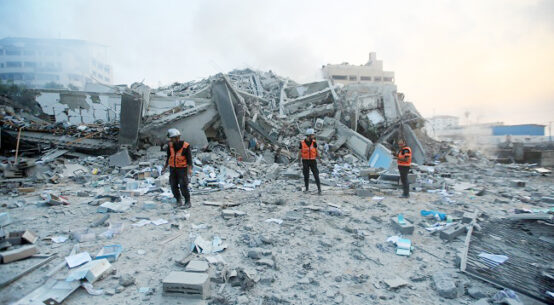Several days after fighting began in Gaza between Israel and Hamas, a flash appeal has been launched seeking $294 million to fund urgent humanitarian work in the region.
According to the United Nations Office for the Coordination of Humanitarian Affairs, which launched the appeal, the funding is needed for many things, including food, shelter, and water to address the “grave humanitarian consequences” of the recent hostilities.
In total, the latest reports state that 2,750 people have been killed and 9,700 injured in Gaza since Oct. 7, with civilians directly targeted by Israeli airstrikes, according to widely reported statements from the Gaza Health Ministry. The same report said that more than 1,400 have been killed in Israel since Oct. 7 and at least 3,621 have been injured. UNRWA, the U.N. agency for Palestinian refugees, estimates that over 1 million people have been displaced within Gaza — almost half of the total population of Gaza.
As of Oct. 16, just over $1 million in donations to the appeal have been reported, although the European Union has this morning said it will triple humanitarian aid to Gaza to over €75 million.
In general, donors have varied in how quickly they have come forward with funds during previous crises. On Syria and Ukraine, significant funds had been pledged by this point, while on other crises such as Ethiopia and Afghanistan, it took longer.
What was the situation before the current conflict?
The recent hostilities have created significant challenges to an aid operation that was already overstretched.
Even before the latest conflict, development institutions supported the occupied Palestinian territories of the Gaza Strip and West Bank. UNOCHA’s preexisting humanitarian response plan for 2023 required $502 million. Of that, around $233 million had been provided so far this year, with the largest donors being the United States, Germany, and the European Union.
Significant additional support had also been flowing into Gaza from Gulf states outside of the U.N. system, with Qatar reportedly contributing around $30 million a month to pay wages and support families.
The 25-mile long strip of coastal land in Gaza is one of the most densely populated places on Earth. Of the 2.1 million people in Gaza, 1.7 million were considered refugees by the United Nations before the current hostilities, while 1.2 million people were struggling to feed their families and were thus considered food insecure by the World Food Programme.
Which are the key development institutions involved?
At the heart of the conflict is the UNRWA. It is one of the smaller U.N. institutions and one of the more precariously funded. UNRWA provides food, education, and health care to Gaza, and has more than 13,000 staffers in the region.
In 2022, according to its annual operational statement it had an annual budget of just under $1.2 billion, almost all in the form of voluntary contributions from U.N. member states. But in recent years it has scrambled to pay staff and meet bills. Its history of brinkmanship has been charted several times by Devex over recent years. In March last year, the agency warned it was near collapse. Previously, it said it risked being unable to pay salaries and meet refugees’ needs. A decision by the former Trump administration in the United States to cut funding in 2018 was reversed in 2021, but a legacy of neglect has left the agency with a backlog of problems to address.
Right now, UNRWA is looking after around two-thirds of the individuals displaced in the current conflict in its schools.
Several other U.N. agencies are also closely involved, particularly UNOCHA and WFP — which has also previously said it does not have the resources necessary for its humanitarian work. Other key players include the International Committee of the Red Cross and several humanitarian INGOs.
What challenges does the development sector face?
One of the most significant challenges is attracting enough funding to pay for a vast humanitarian operation. But beyond that, several other very serious challenges emerge.
One of the main problems is the difficulty guaranteeing the safety of staff. With attacks appearing to be relatively indiscriminate, agencies have already reported significant losses. IFRC has reported the deaths of three staffers of Magen David Adom and four of the Palestinian Red Crescent, while so far, 14 UNRWA staffers are confirmed dead, with the real number likely higher.
For comparison, the BBC quotes UNOCHA as saying that 10 aid workers have been killed in almost two years of conflict in Ukraine.
The sector also faces major challenges in providing aid, because Gaza is currently subject to a state of siege by the Israeli forces, who have cut off electricity, food, and water.
Negotiations to allow a humanitarian corridor to provide aid are ongoing, with U.S. authorities reported to be putting pressure on Egypt, a major recipient of U.S. aid, to allow humanitarian access across the border. However, despite calls from several major relief agencies and allied governments, attempts to establish the corridor have so far been unsuccessful.
Finally, aid organizations face a complex and volatile political environment, without necessarily having the degree of coverage and support from their major donors that they might expect in most conflict situations.
The White House has been strongly supportive of Israel, and several of its close allies have issued messages of support, and even said they will consider offering military aid. Several countries have suggested suspending aid, rather than providing more, with Germany and Austria both announcing they would suspend aid to Palestinians, and European Union officials issuing contradictory statements.
As eyes turn to the United States to understand its position, the country finds itself without an effective government due to chaos in the House of Representatives, which looks likely to slow down any cogent response, creating yet more problems for an already embattled aid community.
David Ainsworth is business editor at Devex, where he writes about finance and funding issues for development institutions.


